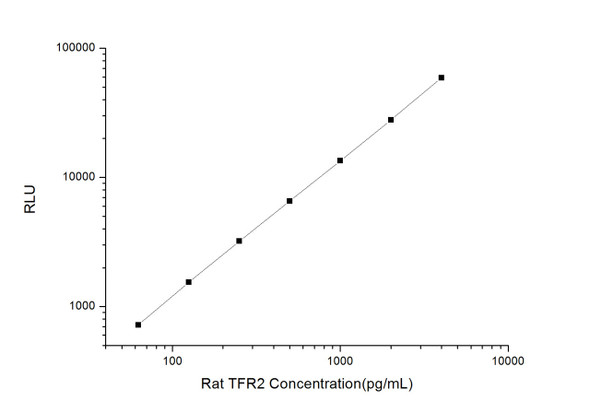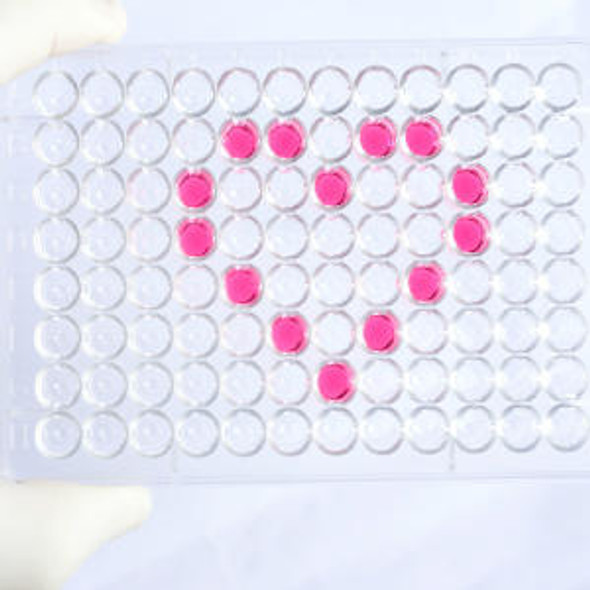Human Cell Biology ELISA Kits 5
Human TFR2 (Transferrin Receptor 2) CLIA Kit (HUES01214)
- SKU:
- HUES01214
- Product Type:
- ELISA Kit
- ELISA Type:
- CLIA Kit
- Size:
- 96 Assays
- Sensitivity:
- 18.75pg/mL
- Range:
- 31.25-2000pg/mL
- ELISA Type:
- Sandwich
- Reactivity:
- Human
- Sample Type:
- Serum, plasma and other biological fluids
- Research Area:
- Cell Biology
Description
| Assay type: | Sandwich |
| Format: | 96T |
| Assay time: | 4.5h |
| Reactivity: | Human |
| Detection method: | Chemiluminescence |
| Detection range: | 31.25-2000 pg/mL |
| Sensitivity: | 18.75 pg/mL |
| Sample volume: | 100µL |
| Sample type: | Serum, plasma and other biological fluids |
| Repeatability: | CV < 15% |
| Specificity: | This kit recognizes Human TFR2 in samples. No significant cross-reactivity or interference between Human TFR2 and analogues was observed. |
This kit uses Sandwich-CLIA as the method. The micro CLIA plate provided in this kit has been pre-coated with an antibody specific to Human TFR2. Standards or samples are added to the appropriate micro CLIA plate wells and combined with the specific antibody. Then a biotinylated detection antibody specific for Human TFR2 and Avidin-Horseradish Peroxidase (HRP) conjugate are added to each micro plate well successively and incubated. Free components are washed away. The substrate solution is added to each well. Only those wells that contain Human TFR2, biotinylated detection antibody and Avidin-HRP conjugate will appear fluorescence. The Relative light unit (RLU) value is measured spectrophotometrically by the Chemiluminescence immunoassay analyzer. The RLU value is positively associated with the concentration of Human TFR2. The concentration of Human TFR2 in the samples can be calculated by comparing the RLU of the samples to the standard curve.
| UniProt Protein Function: | TFR2: Mediates cellular uptake of transferrin-bound iron in a non-iron dependent manner. May be involved in iron metabolism, hepatocyte function and erythrocyte differentiation. Defects in TFR2 are a cause of hemochromatosis type 3 (HFE3). HFE3 is a disorder of iron hemostasis resulting in iron overload and has a phenotype indistinguishable from that of hereditary hemochromatosis (HH). HH is characterized by abnormal intestinal iron absorption and progressive increase of total body iron, which results in midlife in clinical complications including cirrhosis, cardiopathy, diabetes, endocrine dysfunctions, arthropathy, and susceptibility to liver cancer. Since the disease complications can be effectively prevented by regular phlebotomies, early diagnosis is most important to provide a normal life expectancy to the affected subjects. Belongs to the peptidase M28 family. M28B subfamily. 3 isoforms of the human protein are produced by alternative splicing. |
| UniProt Protein Details: | Protein type:Receptor, misc. ; Membrane protein, integral Chromosomal Location of Human Ortholog: 7q22 Cellular Component: cytoplasmic vesicle; external side of plasma membrane; integral to plasma membrane Molecular Function:glycoprotein binding; protein binding; transferrin receptor activity Biological Process: cellular iron ion homeostasis; iron ion homeostasis; positive regulation of endocytosis; positive regulation of transcription from RNA polymerase II promoter; receptor-mediated endocytosis; response to iron ion; transferrin transport Disease: Hemochromatosis, Type 3 |
| NCBI Summary: | This gene encodes a single-pass type II membrane protein, which is a member of the transferrin receptor-like family. This protein mediates cellular uptake of transferrin-bound iron, and may be involved in iron metabolism, hepatocyte function and erythrocyte differentiation. Mutations in this gene have been associated with hereditary hemochromatosis type III. Alternatively spliced transcript variants encoding different isoforms have been described for this gene. [provided by RefSeq, May 2011] |
| UniProt Code: | Q9UP52 |
| NCBI GenInfo Identifier: | 20140912 |
| NCBI Gene ID: | 7036 |
| NCBI Accession: | Q9UP52. 1 |
| UniProt Secondary Accession: | Q9UP52,O75422, Q1HE13, Q9HA99, Q9NX67, A6NGM7, |
| UniProt Related Accession: | Q9UP52 |
| Molecular Weight: | |
| NCBI Full Name: | Transferrin receptor protein 2 |
| NCBI Synonym Full Names: | transferrin receptor 2 |
| NCBI Official Symbol: | TFR2 |
| NCBI Official Synonym Symbols: | HFE3; TFRC2 |
| NCBI Protein Information: | transferrin receptor protein 2 |
| UniProt Protein Name: | Transferrin receptor protein 2 |
| Protein Family: | Transferrin receptor protein |
| UniProt Gene Name: | TFR2 |
| UniProt Entry Name: | TFR2_HUMAN |
As the RLU values of the standard curve may vary according to the conditions of the actual assay performance (e. g. operator, pipetting technique, washing technique or temperature effects), the operator should establish a standard curve for each test. Typical standard curve and data is provided below for reference only.
| Concentration (pg/mL) | RLU | Average | Corrected |
| 2000 | 52658 58784 | 55721 | 55693 |
| 1000 | 22065 25883 | 23974 | 23946 |
| 500 | 11179 10885 | 11032 | 11004 |
| 250 | 5288 5300 | 5294 | 5266 |
| 125 | 2749 2467 | 2608 | 2580 |
| 62.5 | 1313 1309 | 1311 | 1283 |
| 31.25 | 674 674 | 674 | 646 |
| 0 | 27 29 | 28 | -- |
Precision
Intra-assay Precision (Precision within an assay): 3 samples with low, mid range and high level Human TFR2 were tested 20 times on one plate, respectively.
Inter-assay Precision (Precision between assays): 3 samples with low, mid range and high level Human TFR2 were tested on 3 different plates, 20 replicates in each plate.
| Intra-assay Precision | Inter-assay Precision | |||||
| Sample | 1 | 2 | 3 | 1 | 2 | 3 |
| n | 20 | 20 | 20 | 20 | 20 | 20 |
| Mean (pg/mL) | 108.01 | 286.16 | 867.90 | 109.04 | 295.70 | 854.93 |
| Standard deviation | 10.28 | 27.61 | 95.47 | 12.23 | 22.24 | 79.17 |
| C V (%) | 9.52 | 9.65 | 11.00 | 11.22 | 7.52 | 9.26 |
Recovery
The recovery of Human TFR2 spiked at three different levels in samples throughout the range of the assay was evaluated in various matrices.
| Sample Type | Range (%) | Average Recovery (%) |
| Serum (n=5) | 98-114 | 106 |
| EDTA plasma (n=5) | 88-104 | 95 |
| Cell culture media (n=5) | 97-112 | 105 |
Linearity
Samples were spiked with high concentrations of Human TFR2 and diluted with Reference Standard & Sample Diluent to produce samples with values within the range of the assay.
| Serum (n=5) | EDTA plasma (n=5) | Cell culture media (n=5) | ||
| 1:2 | Range (%) | 101-119 | 88-100 | 93-106 |
| Average (%) | 109 | 93 | 98 | |
| 1:4 | Range (%) | 98-114 | 90-106 | 97-112 |
| Average (%) | 104 | 96 | 105 | |
| 1:8 | Range (%) | 93-106 | 97-112 | 84-97 |
| Average (%) | 100 | 103 | 91 | |
| 1:16 | Range (%) | 99-112 | 87-99 | 96-108 |
| Average (%) | 107 | 93 | 102 |
An unopened kit can be stored at 4°C for 1 month. If the kit is not used within 1 month, store the items separately according to the following conditions once the kit is received.
| Item | Specifications | Storage |
| Micro CLIA Plate(Dismountable) | 8 wells ×12 strips | -20°C, 6 months |
| Reference Standard | 2 vials | |
| Concentrated Biotinylated Detection Ab (100×) | 1 vial, 120 µL | |
| Concentrated HRP Conjugate (100×) | 1 vial, 120 µL | -20°C(shading light), 6 months |
| Reference Standard & Sample Diluent | 1 vial, 20 mL | 4°C, 6 months |
| Biotinylated Detection Ab Diluent | 1 vial, 14 mL | |
| HRP Conjugate Diluent | 1 vial, 14 mL | |
| Concentrated Wash Buffer (25×) | 1 vial, 30 mL | |
| Substrate Reagent A | 1 vial, 5 mL | 4°C (shading light) |
| Substrate Reagent B | 1 vial, 5 mL | 4°C (shading light) |
| Plate Sealer | 5 pieces | |
| Product Description | 1 copy | |
| Certificate of Analysis | 1 copy |
- Set standard, test sample and control (zero) wells on the pre-coated plate and record theirpositions. It is recommended to measure each standard and sample in duplicate. Note: addall solutions to the bottom of the plate wells while avoiding contact with the well walls. Ensuresolutions do not foam when adding to the wells.
- Aliquot 100 µL of standard solutions into the standard wells.
- Add 100 µL of Sample / Standard dilution buffer into the control (zero) well.
- Add 100 µL of properly diluted sample (serum, plasma, tissue homogenates and otherbiological fluids. ) into test sample wells.
- Cover the plate with the sealer provided in the kit and incubate for 90 min at 37 °C.
- Aspirate the liquid from each well, do not wash. Immediately add 100 µL of BiotinylatedDetection Ab working solution to each well. Cover the plate with a plate seal and gently mix. Incubate for 1 hour at 37 °C.
- Aspirate or decant the solution from the plate and add 350 µL of wash buffer to each welland incubate for 1-2 minutes at room temperature. Aspirate the solution from each well andclap the plate on absorbent filter paper to dry. Repeat this process 3 times. Note: a microplatewasher can be used in this step and other wash steps.
- Add 100 µL of HRP Conjugate working solution to each well. Cover with a plate seal andincubate for 30 min at 37 °C.
- Aspirate or decant the solution from each well. Repeat the wash process for five times asconducted in step 7.
- Add 100 µL of Substrate mixture solution to each well. Cover with a new plate seal andincubate for no more than 5 min at 37 °C. Protect the plate from light.
- Determine the RLU value of each well immediately.






